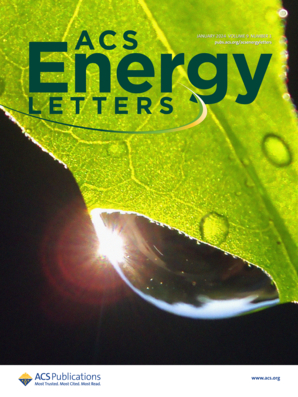Crack-Engineered Microporous Layer for Mitigating Cathode Flooding in Polymer Electrolyte Fuel Cells
IF 19.3
1区 材料科学
Q1 CHEMISTRY, PHYSICAL
引用次数: 0
Abstract
Crack engineering within the microporous layer (MPL) of the gas diffusion layer (GDL) has emerged as a promising strategy to alleviate severe cathode flooding in polymer electrolyte fuel cells (PEFCs), especially under high current operation. Here, we report a connected-crack MPL architecture that forms continuous liquid water highways, extending from the catalyst layer (CL) to the GDL backing layer, effectively separating the liquid/gas transport. Three-dimensional reconstruction using X-ray computed tomography reveals that the microengineered cracks significantly reduce flooding at the CL-MPL interface by providing efficient drainage. Compared to the noncrack GDL, the connected-crack GDL (C-GDL) exhibits 20% higher peak power density of 1.23 W cm–2. Pore-scale simulations further validate the antiflooding capabilities of C-GDL, showing a 25-fold enhancement in water removal. This crack-engineered GDL thus offers an efficient and scalable route to water management challenges, enabling robust and high-performance PEFCs suitable for heavy-duty vehicle electrification.

缓解聚合物电解质燃料电池阴极泛洪的裂缝工程微孔层
在气体扩散层(GDL)的微孔层(MPL)内进行裂缝工程已成为缓解聚合物电解质燃料电池(pefc)中严重阴极泛流的一种有前途的策略,特别是在大电流运行下。在这里,我们报告了一种连接裂缝的MPL结构,它形成了连续的液态水高速公路,从催化剂层(CL)延伸到GDL衬底层,有效地分离了液/气运输。利用x射线计算机断层扫描进行的三维重建显示,微工程裂缝通过提供有效的排水,显著减少了CL-MPL界面的水淹。与无裂纹GDL相比,连接裂纹GDL (C-GDL)的峰值功率密度提高了20%,达到1.23 W cm-2。孔隙尺度模拟进一步验证了C-GDL的抗驱能力,表明其除水能力提高了25倍。因此,这种裂缝设计的GDL为解决水管理挑战提供了一种高效且可扩展的途径,使强大且高性能的pefc适用于重型车辆电气化。
本文章由计算机程序翻译,如有差异,请以英文原文为准。
求助全文
约1分钟内获得全文
求助全文
来源期刊

ACS Energy Letters
Energy-Renewable Energy, Sustainability and the Environment
CiteScore
31.20
自引率
5.00%
发文量
469
审稿时长
1 months
期刊介绍:
ACS Energy Letters is a monthly journal that publishes papers reporting new scientific advances in energy research. The journal focuses on topics that are of interest to scientists working in the fundamental and applied sciences. Rapid publication is a central criterion for acceptance, and the journal is known for its quick publication times, with an average of 4-6 weeks from submission to web publication in As Soon As Publishable format.
ACS Energy Letters is ranked as the number one journal in the Web of Science Electrochemistry category. It also ranks within the top 10 journals for Physical Chemistry, Energy & Fuels, and Nanoscience & Nanotechnology.
The journal offers several types of articles, including Letters, Energy Express, Perspectives, Reviews, Editorials, Viewpoints and Energy Focus. Additionally, authors have the option to submit videos that summarize or support the information presented in a Perspective or Review article, which can be highlighted on the journal's website. ACS Energy Letters is abstracted and indexed in Chemical Abstracts Service/SciFinder, EBSCO-summon, PubMed, Web of Science, Scopus and Portico.
 求助内容:
求助内容: 应助结果提醒方式:
应助结果提醒方式:


